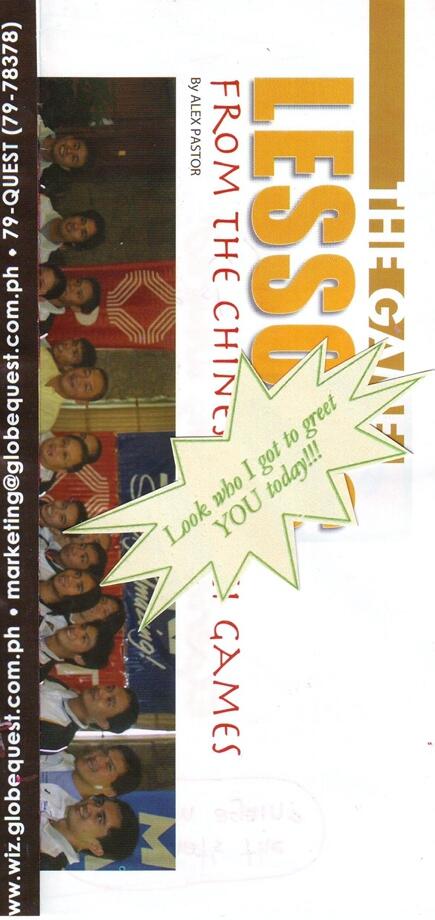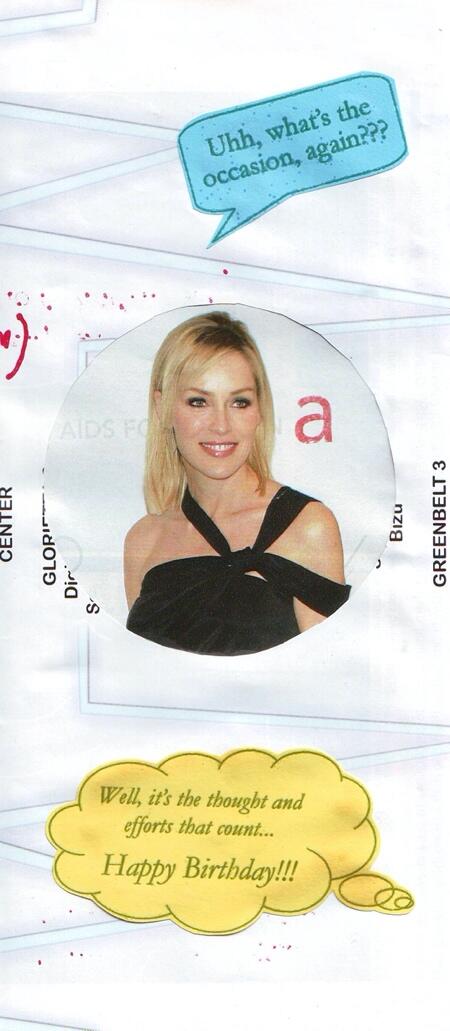Introduction
Corporate social responsibility, as well as environment-consciousness, have been buzzwords for many business organizations and for consumers for a long time now. As issues on the well-being of all parties involved in the product cycle, from manufacturing, delivery to consumption, and even post-consumption, become an integrated part of the whole process of the business and consumption, it is unavoidable to not directly address these issues.
This paper shall try to prepare a one-year marketing communication strategy for a Recycled Magazine Greeting Cards with a budget not exceeding Australian $100,000.00.
Concept Report
Product Description
The recycled magazine greeting cards are made of whole paper pages. Outside is an embossed shout-out message: “Look who I got to greet YOU today!!!” The inside uses a magazine photo of celebrities, such as here, Sharon Stone, but with the message: “Uhh, what’s the occasion again?” also in embossed print. Below is a thought of the sender with: “Well, it’s the thought and efforts that count…Happy Birthday!!!” also embossed. At the back of the card, another recycled logo is in embossed print. The selling points are recycled, the celebrity, and the messages.


Product Issues
It is of note that 100% recycled papers such as magazines may be less attractive to buyers. It is necessary to define the strengths, weaknesses, opportunities, and threats to the recycled magazine greetings cards in order to proceed with its marketing communications strategy.
- Strengths:
- Environment-friendly
- Recycled
- The abundance of raw materials
- Minimum production cost
- A new concept of using totally a whole piece of a magazine page and using printed celebrity photos with their standard, realistic but funny message.
- Weaknesses:
- Less attractive
- A Need to maximize creative ways to make it attractive
- Maximum design cost
- Limited design opportunities
- Opportunities
- Design creativity could provide birth or growth of pioneering designs
- Explore other possibilities for daily, casual, and special occasion greetings
- Branching out to other stationery items using the same materials
- Threats
- Easy copying or pirating of original design and ideas
- Fast dissemination of pirated materials
- Slash of prices among competitions.
As with the organization, there is plenty of growth as the exploration of what may be produced after greeting cards is abundant when it comes to recycling magazines. The raw materials are almost free of cost except for gathering and delivery. In fact, there is an overload of raw materials as many organizations, households, and individuals are compounded on environmental and waste disposal issues. The design process and innovation must be integrated well into the marketing communication in order to send across the right message to the right target market.
In understanding the target consumers, the organization can improve the marketing strategies addressing issues such as the psychology of how consumers think, feel, reason, and select between different alternatives about using eco-friendly cards or recycled greeting cards; how the consumer may be influenced by his or her immediate environment such as the consciousness on environment trend, culture, family, signs, or even media; behavior of consumers while making marketing decisions; the limitations in consumer knowledge or information processing abilities that influence his or her decisions; consumer motivation and decision strategies between products that differ in their level of importance or interest that they entail for the consumer; and how marketers may adapt and improve campaigns and marketing strategies to effectively reach the consumer.
In addressing the issues, marketing communications strategies will take into consideration the maximum exposure target. There are a number of different messages competing for potential customers’ attention through effective advertisements repeated extensively. Consumers may be persuaded by logical arguments or by emotional or symbolic appeals.
Market Situation Issues
Situational Analysis
Recycling papers is a priority among green-consciousness campaigns as papers saved are trees saved. In re-using and maximizing the use of paper, there is a reduction of waste or landfill and a conscious effort to save trees that clean the air. A lot of recycled papers are currently used and developed further for stationery, and other uses with the end aim to reduce waste as well as save on trees. These products, however, go through the same rigorous process of reproducing an entirely new paper product and undergo printing.
There are both high-end and low-end products catering to those who can afford premium greeting cards and those who are after cheaper cards. There are also customized cards for individuals and corporations. Likewise, mass-produced cards are done by various artists and sold by Recycled Paper Greetings and recycled Greeting Cards usually with the marks, “All cards are printed on 100% post-consumer recycled cardstock.”
The introduction of this new concept cuts the whole two processes short, although a different process of the cottage industry of hand-cutting and pasting will be undertaken, aside from the embossed printing of the shout-out messages. The variation of celebrities featured to make the cards stand out as unique, which is another selling point. In this case, also, using humor or emotion, as well as intelligence, the celebrities whom ordinary viewers stare, and admire at a distance become “useful” in the sense that each of the celebrities appears to be exclusively used to greet the recipient of the greeting card.
In selling the product, costs of communicating will consideration the whole product line, and that limiting to a few offers would reduce confusion among customers. Among the strategies include advertising in order to inform customers about the product. Wells et al. (1992) noted that “An important requirement of informal advertising is that the explanation be clear and relevant to the prospect. Consumers have little patience with ads that are confusing, vague or unfocused” (p 247).
It is also important to define the particular segment for the marketing program. Kotler (1997, p 269) suggested that “the segment should be the largest possible homogenous group worth going after with a tailored marketing program.”
For the recycled magazine greeting cards, however, there is undifferentiated marketing so that a single marketing program targets all market segments.
Evaluation
Favorable factors and trends:
- Environment-consciousness.
- Recycling.
- Zero-Waste management.
- Individualism.
- Humour / Comic / Wit.
- Internet retailing.
Unfavorable factors and trends:
- Cheaper and more attractive, mass-produced greeting cards.
- Easy access to competitor greeting cards.
- As a start-up and internet-based retailing, there is a more costly process to delivery of products for less or individual orders.
- Accessibility among a wider consumer group who may not rely online on card purchases.
Market-size or Market Potential
There is a projected small market size for the product as it has to compete against established recycled paper cards, which have popularised their products starting in the 1990s. Likewise, establishing a start-up idea takes time to spread its presence, uniqueness as well as appreciation of people and consumers in general.